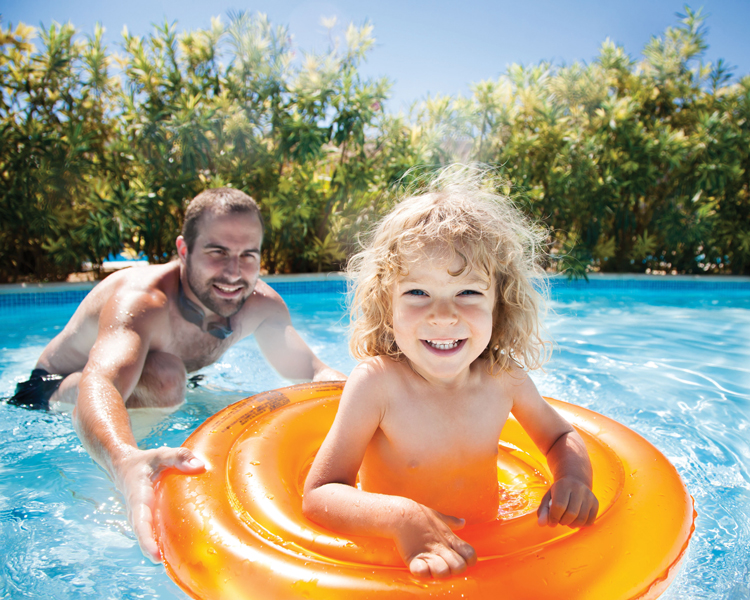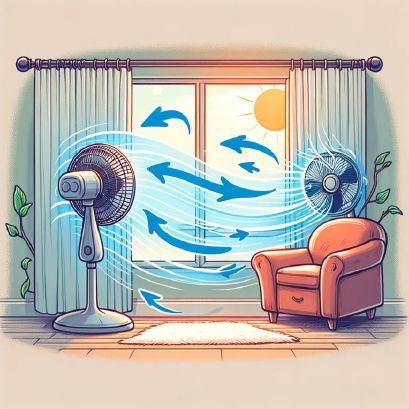
Drinking plenty of fluids is key when it’s hot! Water is best. Limit drinks high in sugar and caffeine, as these can make your body lose fluid, leading to dehydration. It’s also best to limit sports drinks unless you are sweating for multiple hours.

The best thing you can do for mild dehydration is drink more water. Severe dehydration needs immediate medical treatment at a hospital. This may require giving fluids through an intravenous drip (a needle in your arm).
Plan outside activities for early in the day. This means everyone needs to get to bed on time so they can get up early. It also means planning meals ahead of time so you’re not eating dinner too late or rushing through breakfast.
Plan cool activities like taking your children for swimming lessons, or visiting a public swimming pool, lake, or splash pad.

Your local mall or recreation center likely have air conditioning. Visit these places at the hottest times of the day to stay cool while staying physically active.
Keep your parked car cooler by using a windshield shade and parking in an area shaded by trees or other surroundings.
Leather and vinyl car seats can burn skin in the summer. Keep towels in the car to sit on.
Heat exposure during pregnancy has been linked to preterm births, stillbirths, and low birthweight infants. During the first trimester, heat exposure may increase the risk of certain birth defects.

You can bring cool air in and push warm air out by using two fans in front of two windows. In the room you want to cool, place one fan to blow air out one window, and the other fan to blow air in from another window. This will create a nice cross breeze. If possible, put the inward-facing fan in front of a window that’s in the shade.

Open windows in the morning or evening if it’s cooler outside. When it warms up, close windows and shades to keep the sun and heat out.

Make sure your ceiling fan is turning counterclockwise to keep hot air near the ceiling and cooler air below, where you want it. In the winter months, set your ceiling fan to turn clockwise to do the opposite.
When windows are closed, fans don’t cool the room, they cool the people in the room. Save energy (and money) by turning fans off when you leave a room.
Consider doing meal prep in the morning, when temperatures are usually cooler. Avoid using the oven if possible or only use it during the coolest part of the day. Instead use the microwave, slow cooker, toaster oven, or stove top.

Place a fan on the floor with a towel in front of it. Then put a container, bucket or roasting pan filled with ice on top of the towel, directly in front of the fan. The fan will slowly melt the ice and blow out cool, refreshing air.
Dress yourself and your family in loose, lightweight, light-colored clothing.
Bring a water bottle along for everyone in the family.
If the temperature outside is cooler than inside, try eating or reading outside under the shade. Consider taking a fan outside with you, if there’s a safe place to plug it in.
Check out personal fans and handheld misting fans to use when outside. You can also wet a scarf or bandana in cold water then loosely drape it around your neck.

Do you remember running through the sprinkler when you were a kid? Create the same vibe by attaching a simple rotating sprinkler to your garden hose and have fun staying cool!

Check out the HeatRisk Tool from the U.S. Center for Disease Control, and Prevention, where you can find the heat risk and air quality (and how to deal with it) in your town.
Centers for Disease Control. Beat the Heat Infographic:
https://www.cdc.gov/extreme-heat/media/pdf/beat-the-heat-2017.pdf
National Library of Medicine. Pregnancy and Heat Exposure: A Comprehensive Review
on Hot Ambient Temperature and its Impacts on Adverse Pregnancy Outcomes:
https://www.ncbi.nlm.nih.gov/pmc/articles/PMC10298495/
Centers for Disease Control. Clinical Overview of Heat and Pregnancy:
https://www.cdc.gov/heat-health/hcp/clinical-overview/heat-and-pregnant-women.html?CDC_AAref_Val=https://www.cdc.gov/heat-health/hcp/heat-and-pregnant-women.html
Centers for Disease Control HeatRisk Tool:
https://ephtracking.cdc.gov/Applications/HeatRisk/
The Spruce. How to Use Fans to Cool a Room:
https://www.thespruce.com/do-fans-cool-a-room-5271790#:~:text=Move%20cool%20air%20into%20the,line%20from%20the%20first%20windo.
Side-Lying Hold
This hold is useful when:
Cross-Cradle Hold
This hold is useful when:
Clutch or “Football” Hold
This hold is useful when:
Cradle Hold
This hold is useful when:
Laid-Back Hold
This hold is useful when: